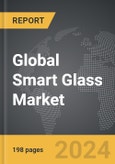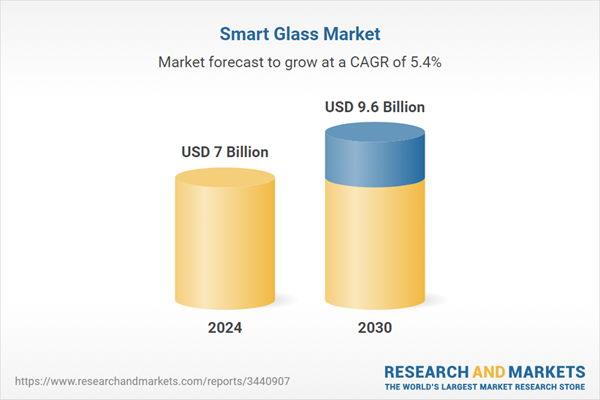The global market for Smart Glass was valued at US$7.0 Billion in 2024 and is projected to reach US$9.6 Billion by 2030, growing at a CAGR of 5.4% from 2024 to 2030. This comprehensive report provides an in-depth analysis of market trends, drivers, and forecasts, helping you make informed business decisions. The report includes the most recent global tariff developments and how they impact the Smart Glass market.
The application of smart glass extends beyond its basic function of light modulation to include significant enhancements in operational efficiency and aesthetic flexibility within buildings. The technology is categorized into two main types: active and passive. Active smart glass utilizes an electrical charge to change states and includes technologies like Polymer Dispersed Liquid Crystal (PDLC) and Suspended Particle Device (SPD), which manage light penetration and privacy dynamically. Passive smart glass, such as photochromic and thermochromic glass, responds to environmental changes like light and temperature, adjusting its tint accordingly without the need for electrical power, making it ideal for energy-efficient applications such as eyewear and responsive windows. These features are particularly beneficial in modern office spaces and hotels, where design and functionality are paramount, allowing for instant privacy adjustments and contributing to a sophisticated, modern aesthetic.
The growth of the smart glass market is propelled by several key factors. Architectural and design innovation continues to drive demand as modern buildings require materials that combine aesthetic appeal with functional performance, including energy efficiency. Regulatory pressures for energy conservation encourage the adoption of smart glass, which can significantly improve a building's energy management by optimizing heat gain and loss. Consumer preference for high-tech amenities has also increased interest in advanced materials like smart glass, which offers a futuristic element to home and office environments. Additionally, advancements in material science and integration with smart home systems are making smart glass a more attractive and feasible option for a wide range of applications. Privacy and security concerns further boost the demand for smart glass, offering a high-tech solution that provides privacy at the switch of a button. Furthermore, the growing awareness of health benefits related to natural light exposure promotes the use of smart glass, which maximizes natural lighting while blocking harmful UV rays, aligning with health and well-being trends. These factors collectively enhance the market reach and implementation of smart glass, marking its significance in the future of building and interior design technology.
Segments: Technology (Electrochromic, Liquid Crystal, Photochromic, Other Technologies); Application (Transportation, Architectural, Other Applications).
Geographic Regions/Countries: World; United States; Canada; Japan; China; Europe (France; Germany; Italy; United Kingdom; and Rest of Europe); Asia-Pacific; Rest of World.
The analysts continuously track trade developments worldwide, drawing insights from leading global economists and over 200 industry and policy institutions, including think tanks, trade organizations, and national economic advisory bodies. This intelligence is integrated into forecasting models to provide timely, data-driven analysis of emerging risks and opportunities.
Global Smart Glass Market - Key Trends and Drivers Summarized
Smart glass, also known as light control glass, represents a significant technological advancement in the fields of architecture, automotive design, interior design, and product innovation. This dynamic material can transition between transparent, translucent, and opaque states, offering control over visible light, UV, and IR emissions. This functionality not only enhances privacy but also plays a crucial role in energy management within buildings. For instance, smart privacy glass allows for the quick switch from clear to opaque, serving a variety of settings and fulfilling the dual needs for natural light and privacy. This innovative technology integrates seamlessly into various applications such as windows, partitions, and other transparent surfaces across multiple industries, revolutionizing the traditional capabilities of glass by adding multifunctional value.The application of smart glass extends beyond its basic function of light modulation to include significant enhancements in operational efficiency and aesthetic flexibility within buildings. The technology is categorized into two main types: active and passive. Active smart glass utilizes an electrical charge to change states and includes technologies like Polymer Dispersed Liquid Crystal (PDLC) and Suspended Particle Device (SPD), which manage light penetration and privacy dynamically. Passive smart glass, such as photochromic and thermochromic glass, responds to environmental changes like light and temperature, adjusting its tint accordingly without the need for electrical power, making it ideal for energy-efficient applications such as eyewear and responsive windows. These features are particularly beneficial in modern office spaces and hotels, where design and functionality are paramount, allowing for instant privacy adjustments and contributing to a sophisticated, modern aesthetic.
The growth of the smart glass market is propelled by several key factors. Architectural and design innovation continues to drive demand as modern buildings require materials that combine aesthetic appeal with functional performance, including energy efficiency. Regulatory pressures for energy conservation encourage the adoption of smart glass, which can significantly improve a building's energy management by optimizing heat gain and loss. Consumer preference for high-tech amenities has also increased interest in advanced materials like smart glass, which offers a futuristic element to home and office environments. Additionally, advancements in material science and integration with smart home systems are making smart glass a more attractive and feasible option for a wide range of applications. Privacy and security concerns further boost the demand for smart glass, offering a high-tech solution that provides privacy at the switch of a button. Furthermore, the growing awareness of health benefits related to natural light exposure promotes the use of smart glass, which maximizes natural lighting while blocking harmful UV rays, aligning with health and well-being trends. These factors collectively enhance the market reach and implementation of smart glass, marking its significance in the future of building and interior design technology.
Report Scope
The report analyzes the Smart Glass market, presented in terms of units. The analysis covers the key segments and geographic regions outlined below.Segments: Technology (Electrochromic, Liquid Crystal, Photochromic, Other Technologies); Application (Transportation, Architectural, Other Applications).
Geographic Regions/Countries: World; United States; Canada; Japan; China; Europe (France; Germany; Italy; United Kingdom; and Rest of Europe); Asia-Pacific; Rest of World.
Key Insights:
- Market Growth: Understand the significant growth trajectory of the Electrochromic segment, which is expected to reach US$7.9 Billion by 2030 with a CAGR of a 5.5%. The Liquid Crystal segment is also set to grow at 4.1% CAGR over the analysis period.
- Regional Analysis: Gain insights into the U.S. market, valued at $1.9 Billion in 2024, and China, forecasted to grow at an impressive 5.2% CAGR to reach $1.5 Billion by 2030. Discover growth trends in other key regions, including Japan, Canada, Germany, and the Asia-Pacific.
Why You Should Buy This Report:
- Detailed Market Analysis: Access a thorough analysis of the Global Smart Glass Market, covering all major geographic regions and market segments.
- Competitive Insights: Get an overview of the competitive landscape, including the market presence of major players across different geographies.
- Future Trends and Drivers: Understand the key trends and drivers shaping the future of the Global Smart Glass Market.
- Actionable Insights: Benefit from actionable insights that can help you identify new revenue opportunities and make strategic business decisions.
Key Questions Answered:
- How is the Global Smart Glass Market expected to evolve by 2030?
- What are the main drivers and restraints affecting the market?
- Which market segments will grow the most over the forecast period?
- How will market shares for different regions and segments change by 2030?
- Who are the leading players in the market, and what are their prospects?
Report Features:
- Comprehensive Market Data: Independent analysis of annual sales and market forecasts in US$ Million from 2024 to 2030.
- In-Depth Regional Analysis: Detailed insights into key markets, including the U.S., China, Japan, Canada, Europe, Asia-Pacific, Latin America, Middle East, and Africa.
- Company Profiles: Coverage of players such as Active Glass Technologies, Asahi Glass Company Ltd., Asahi India Glass Ltd. (AIS), Clayton Glass Ltd., Corning, Inc. and more.
- Complimentary Updates: Receive free report updates for one year to keep you informed of the latest market developments.
Some of the 52 companies featured in this Smart Glass market report include:
- Active Glass Technologies
- Asahi Glass Company Ltd.
- Asahi India Glass Ltd. (AIS)
- Clayton Glass Ltd.
- Corning, Inc.
- Essex Safety Glass Ltd.
- Flat Glass Industries Ltd.
- Gentex Corporation
- Glass Apps, LLC
- Guardian Industries
- Intelligent Glass
- InvisiShade, LLC
- Nippon Sheet Glass Co., Ltd.
- RavenWindow
- Research Frontiers Inc.
- SAGE Electrochromics, Inc.
- Schott Corporation
- Smartglass International Limited
- Vario Glass, Inc.
- View, Inc.
Tariff Impact Analysis: Key Insights for 2025
Global tariff negotiations across 180+ countries are reshaping supply chains, costs, and competitiveness. This report reflects the latest developments as of April 2025 and incorporates forward-looking insights into the market outlook.The analysts continuously track trade developments worldwide, drawing insights from leading global economists and over 200 industry and policy institutions, including think tanks, trade organizations, and national economic advisory bodies. This intelligence is integrated into forecasting models to provide timely, data-driven analysis of emerging risks and opportunities.
What’s Included in This Edition:
- Tariff-adjusted market forecasts by region and segment
- Analysis of cost and supply chain implications by sourcing and trade exposure
- Strategic insights into geographic shifts
Buyers receive a free July 2025 update with:
- Finalized tariff impacts and new trade agreement effects
- Updated projections reflecting global sourcing and cost shifts
- Expanded country-specific coverage across the industry
Table of Contents
I. METHODOLOGYII. EXECUTIVE SUMMARY2. FOCUS ON SELECT PLAYERSIII. MARKET ANALYSISIV. COMPETITION
1. MARKET OVERVIEW
3. MARKET TRENDS & DRIVERS
4. GLOBAL MARKET PERSPECTIVE
UNITED STATES
CANADA
JAPAN
CHINA
EUROPE
FRANCE
GERMANY
ITALY
UNITED KINGDOM
REST OF EUROPE
ASIA-PACIFIC
REST OF WORLD
Companies Mentioned (Partial List)
A selection of companies mentioned in this report includes, but is not limited to:
- Active Glass Technologies
- Asahi Glass Company Ltd.
- Asahi India Glass Ltd. (AIS)
- Clayton Glass Ltd.
- Corning, Inc.
- Essex Safety Glass Ltd.
- Flat Glass Industries Ltd.
- Gentex Corporation
- Glass Apps, LLC
- Guardian Industries
- Intelligent Glass
- InvisiShade, LLC
- Nippon Sheet Glass Co., Ltd.
- RavenWindow
- Research Frontiers Inc.
- SAGE Electrochromics, Inc.
- Schott Corporation
- Smartglass International Limited
- Vario Glass, Inc.
- View, Inc.
Table Information
| Report Attribute | Details |
|---|---|
| No. of Pages | 198 |
| Published | April 2025 |
| Forecast Period | 2024 - 2030 |
| Estimated Market Value ( USD | $ 7 Billion |
| Forecasted Market Value ( USD | $ 9.6 Billion |
| Compound Annual Growth Rate | 5.4% |
| Regions Covered | Global |









